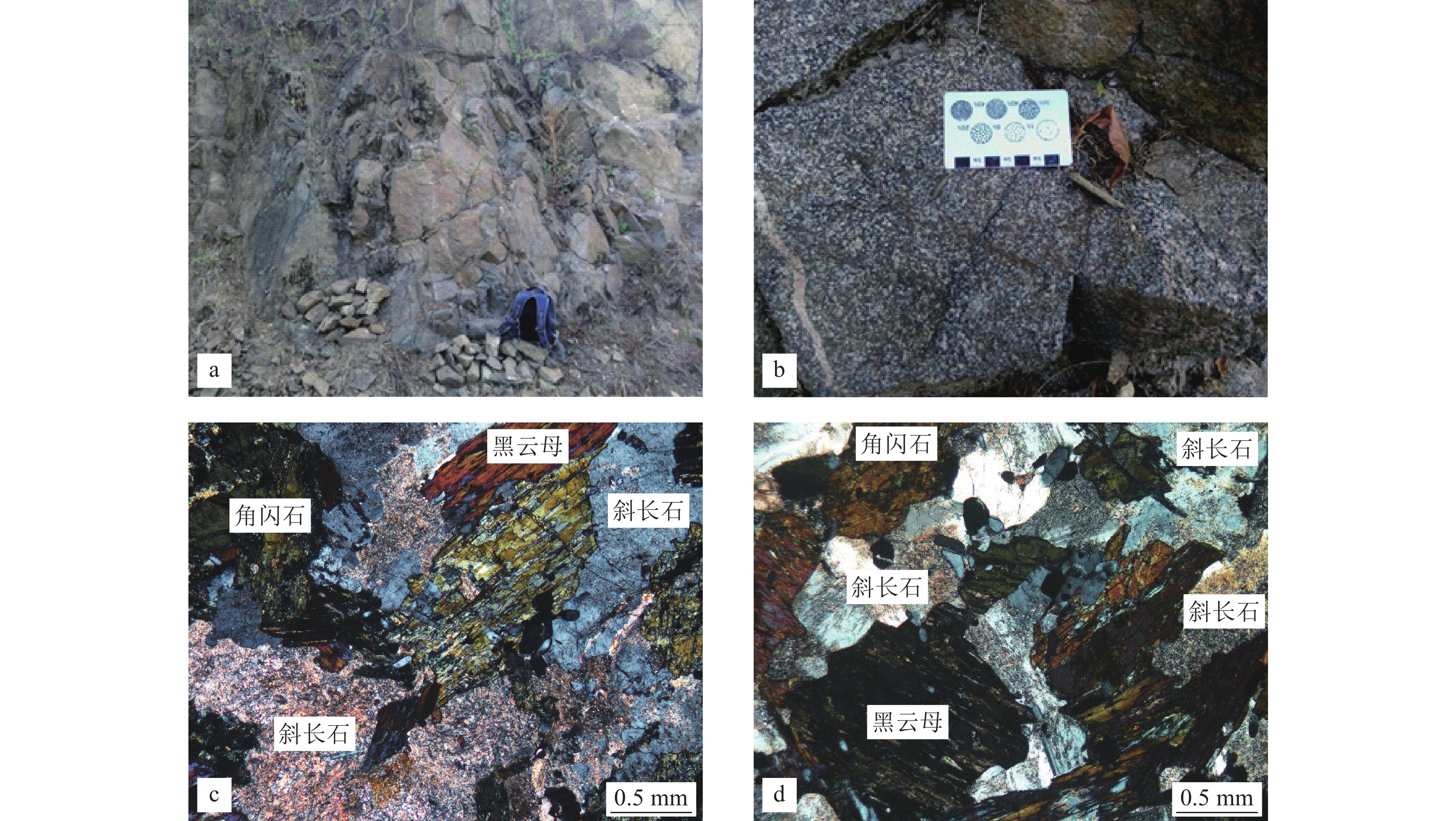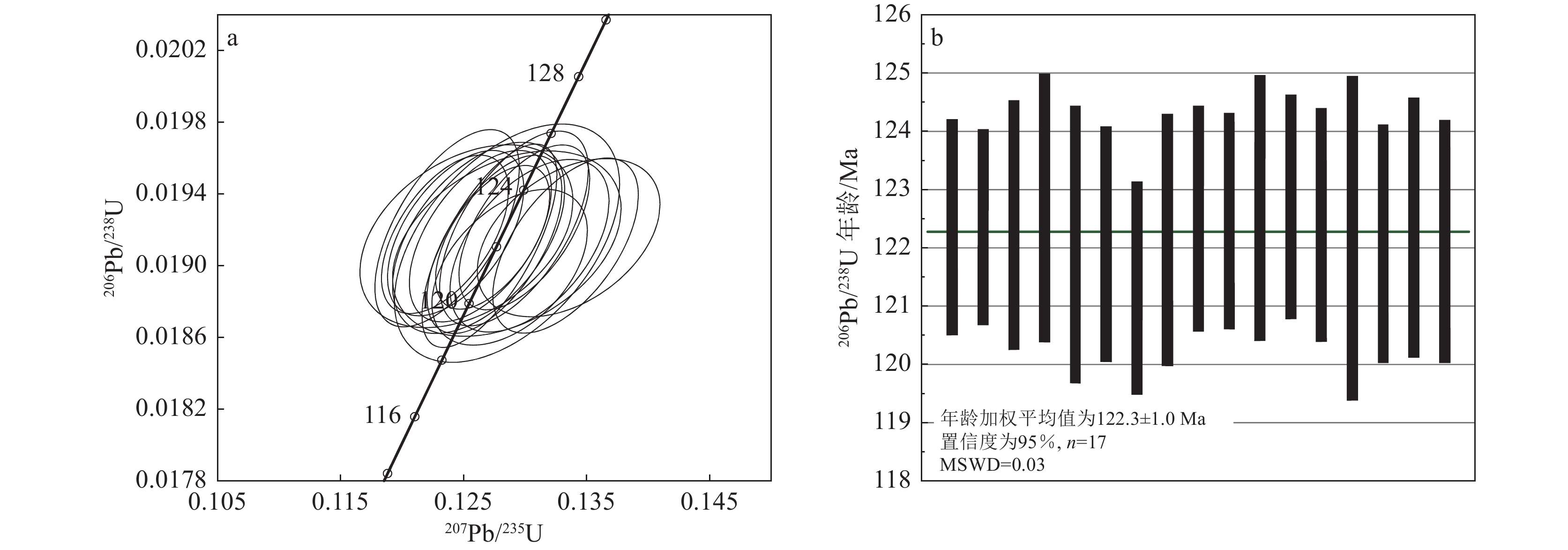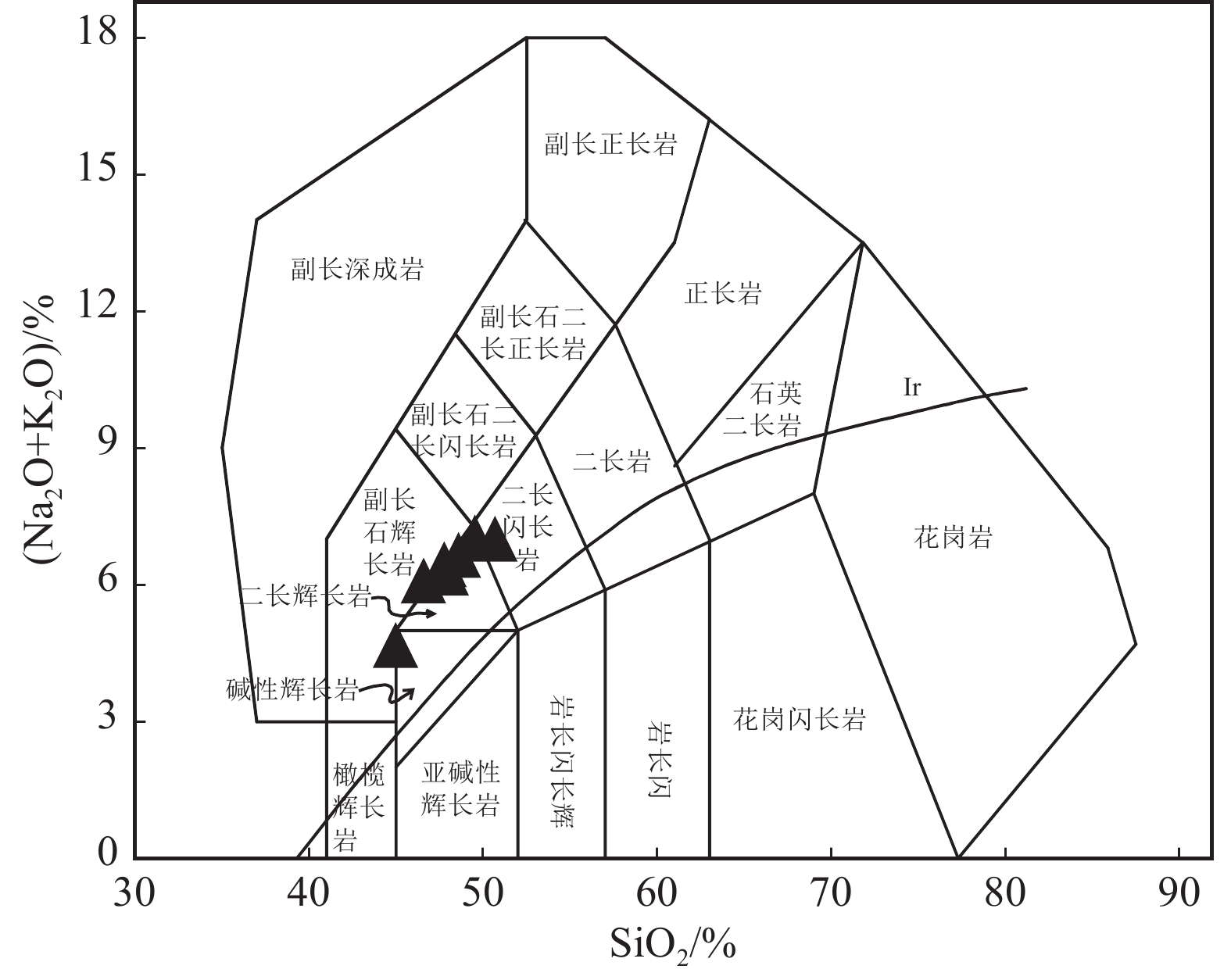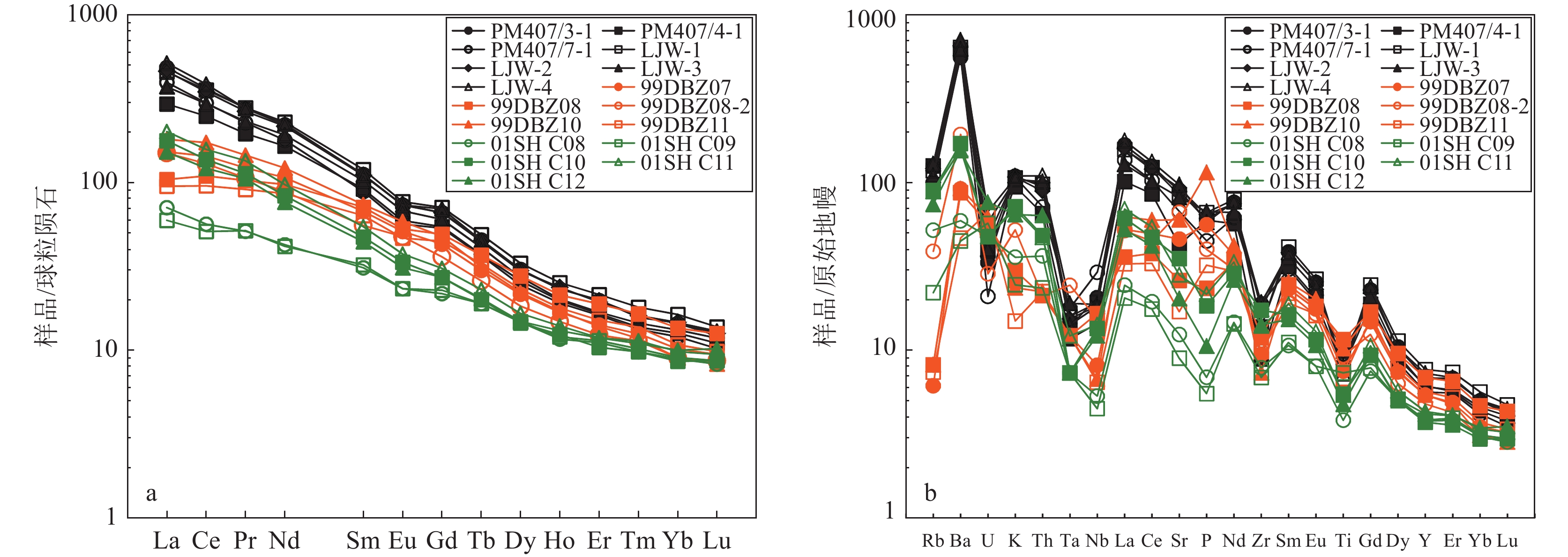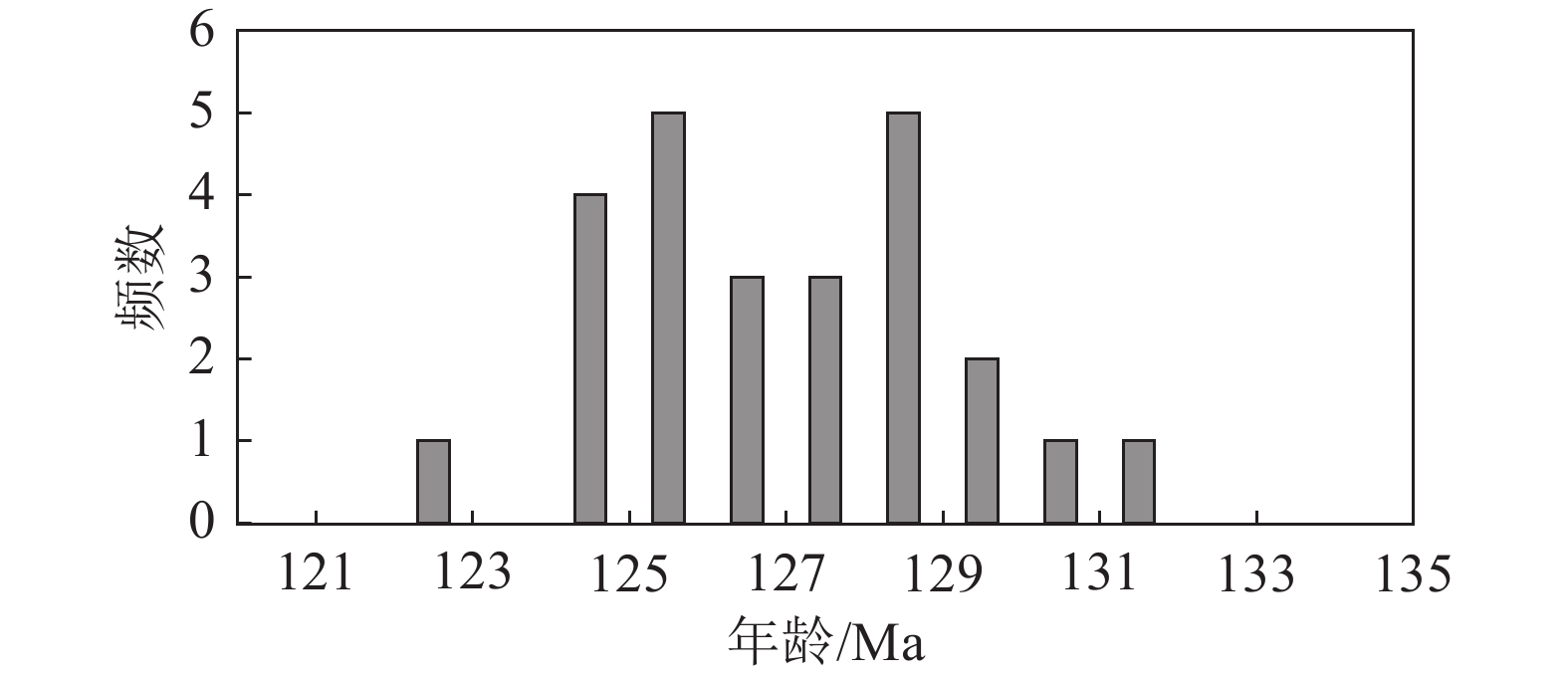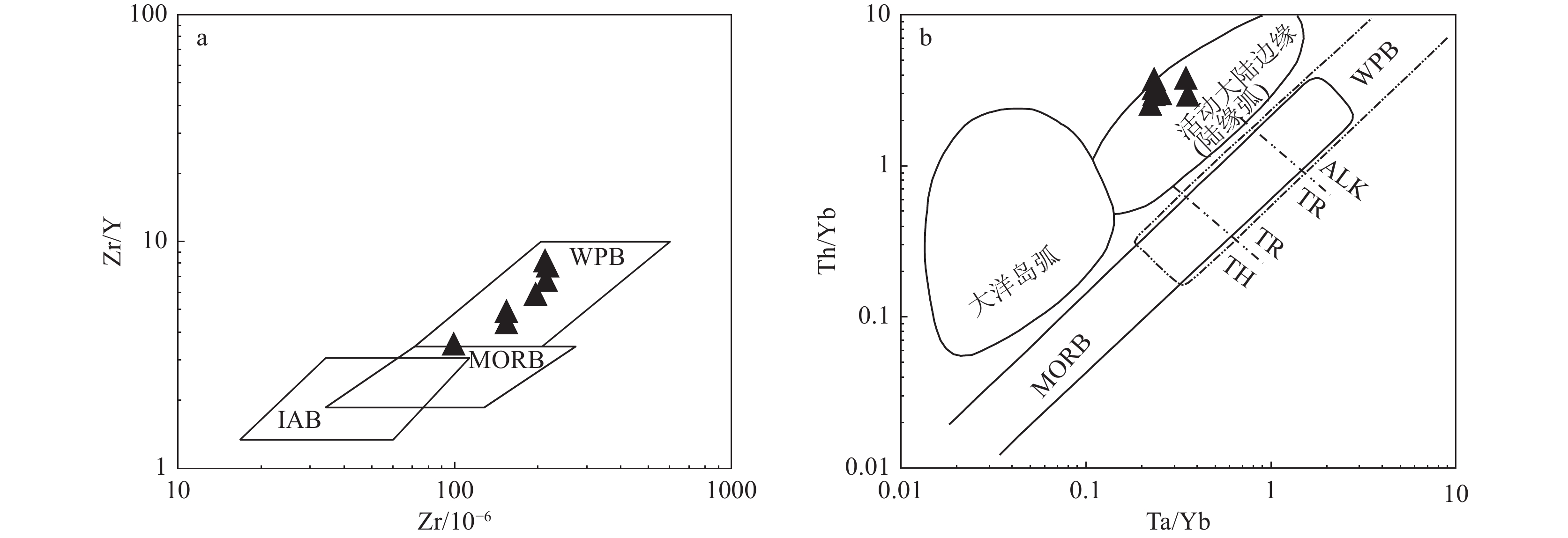Geochemical characteristics of Early Cretaceous gabbro in Muzidian area, North Dabie and its indicative significance for tectonic environment
-
摘要:
为揭示大别造山带基性岩的成因及构造背景,应用LA−ICP−MS锆石定年和地球化学分析,探讨了北大别木子店地区雷家湾辉长岩的成岩年龄、地球化学特征,并通过与安徽段基性—超基性岩对比,揭示了大别造山带基性—超基性岩成因和构造环境。结果显示,北大别木子店地区雷家湾辉长岩成岩年龄为122.3±1.0 Ma。雷家湾辉长岩的SiO2含量介于45.00%~50.69%之间,平均值为48.02%;Mg#值变化范围在45.62~53.49之间,平均值为47.86;K2O+ Na2O含量变化于4.68%~7.03%之间,平均值为6.31%,属于碱性系列;富集Rb、Ba、K、Sr等大离子亲石元素(LILE)和轻稀土元素,亏损Ta、Nb、Zr、Ti等高场强元素(HFSE)和重稀土元素;与安徽段基性—超基性岩具有相似的野外特征和岩石地球化学性质。岩石成因研究显示,雷家湾辉长岩的幔源母岩浆有地壳物质的加入,作用方式应该为源区的混合,地壳物质的加入可能与三叠纪以来扬子板块向华北板块俯冲后加厚岩石圈的拆沉作用有关。大别造山带130 Ma左右基性—超基性岩的出现可能暗示构造体制由挤压向伸展转换。
Abstract:In order to reveal the genesis and tectonic background of basic rocks in Dabie orogenic belt, LA−ICP−MS zircon dating and geochemical analysis were carried out to discuss the diagenetic age and geochemical characteristics of Leijiawan gabbro in Muzidian area, North Dabie, and by comparing with the basic−ultrabasic rocks in Anhui section, the genesis and tectonic environment of Dabie orogenic basic−ultrabasic rocks are revealed. The results show that the diagenetic age of the Leijiawan gabbro in the Muzidian area of North Dabie is 122.3 ± 1.0 Ma. The SiO2 content of the Leijiawan gabbro is between 45.00% and 50.69%, with an average of 48.02%. The Mg# value ranged from 45.62 to 53.49, with an average of 47.86.The content of K2O + Na2O varied from 4.68% to 7.03%, with an average of 6.31 %, belonging to the alkaline series. It is enriched in light rare earth elements and large ion lithophile elements ( LILE ) such as Rb, Ba, K and Sr, and depleted in heavy elements and high field strength elements ( HFSE ) such as Ta, Nb, Zr and Ti. It has similar field and geochemical characteristics to the mafic−ultramafic rocks of Anhui. The petrogenesis study shows that the mantle−derived magma of Leijiawan gabbro was added with crustal materials, and the mode of action is the mixing in magma source. The addition of crustal material may be related to the delamination of thickened lithosphere after subduction of Yangtze plate to North China plate since Triassic. The occurrence of mafic−ultramafic rocks at ca. 130 Ma in Dabie orogenic belt may imply the structural system transforms from compression to extension.
-
大别造山带不仅出露大面积的高压—超高压变质岩,而且发育大量的碰撞后岩浆岩(马昌前等,1999,2003;赵子福等,2009)。前人同位素年代学研究表明,大别造山带碰撞后岩浆活动高峰期为120~135 Ma(Xue et al., 1997;Hacker et al., 1998;薛怀民等,2002;赵子福等,2004;Xie et al., 2006;Wu et al., 2007;续海金等,2008)。这些燕山期的侵入岩以中酸性为主,同时还发育许多基性—超基性岩石。由于基性—超基性岩蕴含有大量的幔源信息,对这些岩石的研究,有助于了解大别造山带深部壳幔的地球化学特征及其相互作用。
从已有的资料看,前人对这些基性—超基性岩进行了一定的年代学和地球化学方面的研究(李曙光等,1997,1998,1999;陈道公等,1997,2001;聂永红等,1997;葛宁洁等,1999;王江海等,2002;王世明等,2010;Dai et al., 2011;谢清陆等,2016),但与同时期发育的中酸性岩相比,其研究程度明显不足。另外,前人的研究工作主要集中在北大别安徽段几个大的岩体,如椒子岩(陈道公等,1997;Zhao et al., 2005;李全忠等,2008)、沙村岩体(葛宁洁等,1999;赵子福等,2003;Zhao et al., 2005)等,对其他地方的基性—超基性岩报道较少。从近期工作看,在北大别湖北段也发育类似的基性—超基性岩,但野外特征上,相比于安徽段几个尚未发生变质变形的基性—超基性岩,湖北段基性—超基性岩发生了强烈的变质作用。这两类野外特征不同的基性—超基性岩,是否具相同的形成年龄和地球化学特征是需要查明的问题。对该问题的探讨,有助于对整个北大别地区基性—超基性岩的年代学研究和成因分析。
本文在1∶5万区域地质调查填图基础上,对北大别木子店地区的雷家湾辉长岩进行了岩石学、地球化学和年代学研究,并通过与安徽段基性—超基性岩研究成果进行对比,探讨了雷家湾辉长岩的岩石成因及其构造意义,为北大别地区晚中生代岩浆演化研究提供资料。
1. 地质背景及岩石学特征
大别造山带是三叠纪形成的碰撞造山带(徐树桐等,1992;徐树桐等,1994;杨巍然等,1999;汤加富等,2003;王勇生等,2004),先后经历了挤压作用、伸展作用、岩石圈减薄等多阶段作用过程(索书田等,2001;李曙光,2004;吴元保,2009;林伟等,2013;王清晨,2013;刘晓春等,2015)。大别造山带的东侧以郯庐断裂为界,西侧延伸可与秦岭造山带相连。碰撞后的伸展作用和晚燕山期以来的构造坍塌造就了大别造山带现今的构造样式。根据变质温度−压力条件,前人将该带划分为5个构造单元(Zheng et al., 2005),由北至南分别为北淮阳构造单元、北大别构造单元、超高压构造单元、高压构造单元和蓝闪−绿片岩构造单元。
大别造山带发育较多的燕山期基性—超基性岩,从分布位置看,它们主要位于北大别构造单元内。野外以小型侵入体、团块状或脉状与围岩呈侵入接触关系。本次研究的雷家湾岩体位于麻城市木子店镇北东方向13 km处,处于北大别构造单元罗田穹隆核部位置(图1)。岩体近卵圆形,直径约2 km,与围岩二长花岗岩呈侵入接触。从岩体中心向边部,岩性由辉长岩逐渐过渡到闪长岩。野外特征上,雷家湾岩体发生强烈的变质,局部形成斜长角闪岩。本次采集的雷家湾辉长岩,呈灰绿色,半自形—自形柱状结构,块状构造(图2−a,b)。主要矿物有斜长石、辉石、角闪石、黑云母、石英等,少量副矿物为磁铁矿、磷灰石、榍石等。斜长石呈板柱状,晶体表面普遍布满粘土矿物集合体(图2−c),但仍可见聚片双晶;辉石呈半自形—他形,多蚀变为角闪石;角闪石呈黄绿色柱状,伴有透闪石化;黑云母全部被绿泥石和铁质集合体取代,具残余片状假象(图2−d);石英呈他形粒状分布于长石粒间。副矿物磁铁矿多呈包体分布于主要矿物晶体内,磷灰石多呈包体较集中分布于暗色矿物晶体内,榍石呈楔形与磁铁矿伴生。
2. 样品分析方法
选取1个辉长岩样品(采样位置: 北纬31°14′28″、东经115°29′41″) 的锆石用于LA−ICP−MS U−Pb年龄分析,针对7个辉长岩样品进行了岩石全分析。
野外采集约25 kg的辉长岩样品,采用常规方法进行粉碎,经淘洗、电磁分选等步骤后分离出锆石﹐在双目镜下挑选锆石颗粒,将其粘在环氧树脂上进行制靶﹐用阴极发光(CL)照相确定锆石颗粒内部结构,便于后期进行锆石U−Pb同位素测定。锆石阴极发光CL照相在JSM6510扫描电镜上完成。
锆石的U−Pb年龄测定由中国地质调查局武汉地质调查中心实验室完成。锆石LA−ICP−MS定年采用的仪器型号为icapQ型,配备有 RESOlution 193 nm ArF 准分子激光剥蚀系统,束斑直径为29 μm,频率为6~8 Hz。采用标准锆石91500校正U−Pb同位素,NIST SRM612校正元素含量。单个数据点误差为1σ。采用ICPMSDataCal软件(ver.10.9)对同位素组成数据进行处理(Liu et al., 2008)。采用Isoplot程序计算锆石年龄加权平均值和谐和图的绘制(Ludwig, 2003)。
主量、微量元素测试在自然资源部中南矿产资源监督检测中心完成。主量元素采用波长色散X荧光光谱仪分析,型号为荷兰PW2440,误差优于3.2%;微量元素分析仪器为法国JY38S型光谱仪,误差优于4% 。
3. 分析结果
3.1 锆石U−Pb 年龄
对雷家湾辉长岩样品中17颗锆石进行了LA−ICP−MS定年测试,每颗锆石测试一个点,其同位素分析结果见表1。样品锆石呈无色、浅粉色,透明—半透明,晶形为半自形—他形。锆石晶体粗大,通常在150~200 μm之间,个别可达300 μm,虽然部分碎裂,但总体仍保留了较好的晶形,大部分晶体显示较好的振荡环带(图3)。锆石Th含量为72×10−6~1734×10−6,平均值804×10−6;U含量为97×10−6~596×10−6,平均值288×10−6;Th/U值较高,平均为2.61。这些特征表明,该锆石为辉长岩中典型的岩浆锆石。从本次测试的同位素数据看,17颗锆石点较集中,206Pb/238U年龄介于121.3±1.8~122.7±2.3 Ma之间(图4),其年龄加权平均值为122.3±1.0 Ma(MSWD=0.03,置信度为95%),代表辉长岩的结晶年龄。
表 1 雷家湾辉长岩LA−ICP−MS锆石U−Th−Pb同位素分析结果Table 1. Result of zircon LA−ICP−MS U−Th−Pb dating for the Leijiawan gabbro分析号 含量/10−6 232Th/
238U同位素比值 同位素年龄/Ma 谐和度 Total
Pb232Th 238U 207Pb/
206Pb1σ 207Pb/
235U1σ 206Pb/
238U1σ 207Pb/
206Pb1σ 207Pb/
235U1σ 206Pb/
238U1σ LJW-1-1 19.9 532 192 2.77 0.05060 0.0018 0.1335 0.0049 0.01916 0.00029 233.4 81.5 127.2 4.4 122.4 1.8 96% LJW-1-2 36.0 1082 451 2.40 0.04833 0.0011 0.1273 0.0031 0.01916 0.00026 122.3 53.7 121.7 2.8 122.4 1.7 99% LJW-1-3 8.9 236 139 1.70 0.04718 0.0019 0.1252 0.0057 0.01917 0.00034 57.5 92.6 119.7 5.2 122.4 2.1 97% LJW-1-4 22.5 654 211 3.10 0.04714 0.0016 0.1236 0.0039 0.01921 0.00036 57.5 74.1 118.4 3.5 122.7 2.3 96% LJW-1-5 50.0 1576 596 2.64 0.04815 0.0010 0.1271 0.0036 0.01911 0.00037 105.6 48.1 121.4 3.3 122.1 2.4 99% LJW-1-6 28.3 829 254 3.26 0.04949 0.0015 0.1303 0.0043 0.01912 0.00032 172.3 70.4 124.4 3.8 122.1 2.0 98% LJW-1-8 31.3 1014 274 3.70 0.04913 0.0015 0.1287 0.0042 0.01900 0.00029 153.8 76.8 122.9 3.8 121.3 1.8 98% LJW-1-10 6.4 72 129 0.56 0.04880 0.0023 0.1285 0.0061 0.01913 0.00034 200.1 104.6 122.7 5.5 122.1 2.2 99% LJW-1-11 30.1 937 359 2.61 0.04691 0.0012 0.1243 0.0036 0.01918 0.00030 42.7 63.0 119.0 3.3 122.5 1.9 97% LJW-1-12 53.3 1734 422 4.11 0.04685 0.0013 0.1235 0.0034 0.01918 0.00029 42.7 63.0 118.2 3.1 122.5 1.8 96% LJW-1-13 24.3 779 250 3.12 0.04875 0.0014 0.1291 0.0040 0.01921 0.00036 200.1 73.1 123.3 3.6 122.7 2.3 99% LJW-1-14 22.7 622 376 1.65 0.04901 0.0012 0.1299 0.0035 0.01922 0.00030 146.4 59.3 124.0 3.1 122.7 1.9 98% LJW-1-15 41.7 1316 362 3.63 0.04779 0.0013 0.1263 0.0038 0.01917 0.00031 100.1 58.3 120.8 3.4 122.4 2.0 98% LJW-1-16 4.7 85 97 0.88 0.04965 0.0024 0.1285 0.0060 0.01913 0.00044 189.0 119.4 122.7 5.4 122.2 2.8 99% LJW-1-18 24.9 778 230 3.38 0.05091 0.0015 0.1332 0.0039 0.01912 0.00032 235.3 66.7 127.0 3.5 122.1 2.0 96% LJW-1-19 14.2 385 225 1.71 0.04780 0.0016 0.1262 0.0046 0.01916 0.00035 100.1 77.8 120.7 4.2 122.4 2.2 98% LJW-1-20 31.5 1030 325 3.17 0.04847 0.0013 0.1275 0.0036 0.01912 0.00033 120.5 63.0 121.8 3.3 122.1 2.1 99% 3.2 主量元素
对雷家湾辉长岩7个样品进行了主量和微量元素分析,测试结果见表2。样品的烧失量为1.94%~4.12%,为了减少蚀变对岩石组分分析的影响,将烧失量扣除后,重新计算元素含量并归一至100%。岩石SiO2含量介于45.00%~50.69%之间,平均值为48.02%,属于基性岩范围。Al2O3含量介于11.88%~16.72%之间,平均值为15.42%。TFeO含量介于9.91%~15.64%之间,平均值为12.45%。MgO含量介于4.86%~8.44%之间,平均值为5.81%。TiO2含量介于1.61%~2.23%之间,平均值为1.79%。CaO含量介于6.64%~9.95%之间,平均值为8.16%。P2O5含量介于1.01%~1.50%之间,平均值为1.34%。K2O+ Na2O含量变化于4.68%~7.03%之间,平均值为6.31%,属于碱性系列。Mg#值变化范围在45.62~53.49之间,平均值为47.86,明显比原生岩浆的Mg#值低(60~71),暗示岩浆可能经历了结晶分异作用。在SiO2−(Na2O+K2O)图解(图5)中,所有样品点都落在碱性范围。
表 2 雷家湾辉长岩主量、微量和稀土元素分析结果Table 2. Major, trace and rare earth elements data for the Leijiawan gabbro样号 PM407/3-1 PM407/4-1 PM407/7-1 LJW-1 LJW-2 LJW-3 LJW-4 SiO2 48.13 43.20 49.12 46.71 46.58 45.37 47.38 TiO2 1.63 2.14 1.71 1.70 1.65 1.75 1.57 Al2O3 16.16 11.41 16.20 14.84 15.52 14.76 16.02 Fe2O3 4.68 6.20 3.34 5.11 5.06 5.77 4.88 FeO 6.87 9.44 6.60 7.63 7.53 7.98 7.06 TFeO 11.08 15.02 9.61 12.23 12.08 13.17 11.45 MnO 0.17 0.18 0.15 0.18 0.18 0.19 0.18 MgO 4.72 8.10 5.58 5.40 5.12 5.69 4.88 CaO 6.67 9.55 6.43 8.39 8.16 8.48 7.78 Na2O 3.55 1.64 3.56 2.89 3.05 2.79 3.18 K2O 3.28 2.85 3.23 3.21 3.24 3.14 3.30 P2O5 1.30 1.30 0.98 1.44 1.40 1.46 1.26 烧失量 3.21 4.12 3.88 1.94 2.20 2.20 2.14 总量 100.37 100.13 100.78 99.44 99.69 99.58 99.63 Mg# 45.75 51.64 53.49 46.65 45.62 46.10 45.76 La 115 69.6 93.6 108 109 88.1 122 Ce 222 152 182 218 212 180 236 Pr 26.3 18.6 21.6 26.5 25.2 22.0 26.2 Nd 103 77.0 83.6 107 101 89.7 104 Sm 17.1 14.0 13.5 18.3 16.9 15.7 17.0 Eu 4.26 3.44 3.28 4.46 4.28 3.93 4.26 Gd 13.6 11.2 11.0 14.6 13.6 12.4 14.3 Tb 1.70 1.39 1.37 1.83 1.67 1.53 1.69 Dy 7.70 6.58 6.24 8.38 7.56 6.91 7.62 Ho 1.31 1.12 1.08 1.43 1.34 1.14 1.31 Er 3.27 2.73 2.67 3.55 3.20 2.79 3.30 Tm 0.410 0.350 0.340 0.460 0.410 0.370 0.400 Yb 2.46 2.15 2.05 2.78 2.49 2.25 2.48 Lu 0.310 0.280 0.260 0.350 0.320 0.300 0.330 Y 31.1 27.9 25.6 34.9 31.4 27.6 33.2 ΣREE 518 360 423 516 499 427 541 LREE 488 335 398 482 468 399 509 HREE 30.8 25.8 25.0 33.4 30.6 27.7 31.4 LREE/HREE 15.9 13.0 15.9 14.4 15.3 14.4 16.2 LaN/YbN 33.5 23.2 32.8 27.9 31.4 28.1 35.3 δEu 0.854 0.840 0.823 0.834 0.863 0.861 0.835 Rb 63.5 79.8 78.4 74.7 76.6 82.2 70.0 Ba 4000 4320 3890 4460 4560 4950 4370 U 0.700 0.820 0.440 1.41 0.990 1.21 0.840 Th 8.03 5.54 6.08 8.29 7.54 8.62 9.34 Ta 0.570 0.480 0.730 0.650 0.630 0.780 0.580 Nb 14.7 10.3 20.8 13.7 13.1 13.4 13.0 Pb 11.2 9.8 11.8 12.1 12.9 12.5 12.4 Sr 1880 895 1420 1780 1960 1720 2050 Zr 154 99 212 154 214 217 196 Hf 4.14 3.23 4.80 3.98 4.89 4.99 4.50 注:TFeO=FeO+Fe2O3*0.8998;Mg#=100*MgO/[MgO+0.505*(FeO+0.9*Fe2O3)];δEu=Eu/Eu∗=2EuN/(SmN+GdN) ;主量元素含量单位为%,微量和稀土元素含量单位为10−6 3.3 稀土和微量元素
样品稀土、微量元素测试结果见表2。在稀土元素球粒陨石标准化配分模式图中,7个样品均表现出相同的稀土元素配分模式(图6−a)。样品稀土元素总量(∑REE)变化范围为360×10−6~541×10−6,平均值为469×10−6;其中轻稀土元素(LREE)平均含量为440×10−6,重稀土元素(HREE)平均含量为29.2×10−6;LREE/HREE值为13.0~16.2,(La/Yb)N值为23.2~35.3,δEu为0.823~0.863。雷家湾辉长岩强烈富集LREE,亏损HREE,轻、重稀土元素分馏明显;稀土元素配分曲线为右倾模式,其特点与碱性玄武岩相似。无或弱负Eu异常,指示早期没有或者很少有斜长石析出。微量元素蛛网图(图6−b)显示,雷家湾辉长岩总体富集Rb、Ba、K、Sr等大离子亲石元素(LILE),亏损高场强元素(HFSE)Ta、Nb、Zr、Ti等,与岛弧型火山岩具有相似的微量元素特征。
![]() 图 6 北大别不同地段基性—超基性岩稀土元素球粒陨石标准化配分图(a)和微量元素原始地幔标准化蛛网图(b)a—不同地段基性−超基性岩稀土元素球粒陨石标准化配分图;b—不同地段基性−超基性岩微量元素原始地幔标准化蛛网图;99DBZ—椒子岩数据(据李全忠等,2008);01SHC—沙村数据(据赵子福等,2003)Figure 6. Chondrite-normalized REE petterns (a) and trace element spider diagram (b) for mafic-ultramafic rocks in different regions of North Dabie
图 6 北大别不同地段基性—超基性岩稀土元素球粒陨石标准化配分图(a)和微量元素原始地幔标准化蛛网图(b)a—不同地段基性−超基性岩稀土元素球粒陨石标准化配分图;b—不同地段基性−超基性岩微量元素原始地幔标准化蛛网图;99DBZ—椒子岩数据(据李全忠等,2008);01SHC—沙村数据(据赵子福等,2003)Figure 6. Chondrite-normalized REE petterns (a) and trace element spider diagram (b) for mafic-ultramafic rocks in different regions of North Dabie4. 讨 论
4.1 北大别不同地段基性岩对比
早期,由于测试手段和测试精度的不同,关于北大别中生代基性—超基性岩的形成时代有不同认识,主要分为印支期和燕山期(同碰撞和碰撞后)2种观点(李曙光等,1989,1997,1998,1999;Hacker et al., 1995,1998;陈道公等,1997,2001;聂永红等,1997,1998;Jahn et al.,1999;葛宁洁等,1999;Tsai et al., 2000)。随着近年来高精度锆石U−Pb同位素定年方法越来越普及,学者们对北大别基性—超基性岩的形成时代已初步达成共识,即主体侵位时间为130~120 Ma(Hacker et al., 1998;葛宁洁等,1999;李曙光等,1999;王江海等,2002;Wang et al., 2005;Zhao et al., 2005;王世明等,2010;Dai et al., 2011;Dai et al., 2012;谢清陆等,2016)。本次在北大别湖北段木子店地区采集的雷家湾辉长岩的结晶年龄为122.3±1.0 Ma,与北大别安徽段基性—超基性岩形成时代在误差范围内一致(表3;图7),进一步说明北大别不同地段的基性—超基性岩均形成于燕山期(碰撞后)。
表 3 大别造山带中生代基性—超基性岩年龄Table 3. Isotope age of the Mesozoic mafic-ultramafic rocks from Dabie Orogenic belt位置/岩体 岩性 年龄/Ma 定年方法 参考文献 小河口 闪长岩 127±6 TIMS锆石 李曙光等,1999 小河口 辉石岩 125.3±0.8 TIMS锆石 李曙光等,1999 祝家铺 闪长岩 130.2±1.4 TIMS锆石 李曙光等,1999 漆柱山 辉长岩 122.9±0.6 TIMS锆石 王江海等,2002 北大别 辉绿岩脉 128.3±0.1 全岩Ar−Ar Wang et al., 2005 北大别 煌斑岩 128.2±0.2 全岩Ar−Ar Wang et al., 2005 北大别 煌斑岩 129.6±0.2 全岩Ar−Ar Wang et al., 2005 北大别 辉绿岩脉 131.8±0.3 全岩Ar−Ar Wang et al., 2005 北大别 辉绿岩脉 127.6±0.2 全岩Ar−Ar Wang et al., 2005 沙村 辉长岩 128±2 TIMS锆石 Zhao et al., 2005 沙村 辉长岩 125±2 SHRIMP锆石 Zhao et al., 2005 沙村 辉长岩 125±3 SHRIMP锆石 Zhao et al., 2005 椒子岩 辉长岩 127±3 TIMS锆石 Zhao et al., 2005 金寨银沙畈 辉长岩脉 125.8±2.7 SHRIMP锆石 王世明等,2010 湖北大悟 闪斜煌斑岩脉 129.6±2.5 SHRIMP锆石 王世明等,2010 北淮阳 基性岩脉 129±1 SIMS锆石 Dai et al., 2011 道士冲 富斜长石角闪石岩 125±1 SIMS锆石 Dai et al., 2011 道士冲 富斜长石角闪石岩 129±1 LA−ICP−MS锆石 Dai et al., 2011 祝家铺 辉石岩 128±1 SIMS锆石 Dai et al., 2011 祝家铺 辉石岩 126±1 LA−ICP−MS锆石 Dai et al., 2011 祝家铺 富斜长石角闪石岩 126±2 SIMS锆石 Dai et al., 2011 祝家铺 富斜长石角闪石岩 126±1 LA−ICP−MS锆石 Dai et al., 2011 道士冲 角闪石岩 129±1 LA−ICP−MS锆石 Dai et al., 2012 祝家铺 角闪石岩 125±3 LA−ICP−MS锆石 Dai et al., 2012 道士冲 富斜长石角闪石岩 127±2 LA−ICP−MS锆石 Dai et al., 2012 祝家铺 角闪石岩 127±1 LA−ICP−MS锆石 Dai et al., 2012 ![]() 图 7 大别造山带中生代基性—超基性岩年龄频率图(资料来源见表3)Figure 7. Age spectrogram of the Mesozoic mafic-ultramafic rocks in the Dabie Orogenic belt
图 7 大别造山带中生代基性—超基性岩年龄频率图(资料来源见表3)Figure 7. Age spectrogram of the Mesozoic mafic-ultramafic rocks in the Dabie Orogenic belt从野外岩石特征看,雷家湾岩体从岩体中心向边部,岩性由辉长岩逐渐过渡到闪长岩,与安徽段基性—超基性岩具有相似的特征(葛宁洁等,1999;赵子福等,2003)。岩石化学方面,将2个地段的基性—超基性岩进行对比(图6)发现,二者具有相同的元素地球化学特征,均富集轻稀土元素和Rb、Ba、K、Sr等大离子亲石元素,明显亏损高场强元素(Ta、Nb、Zr、Ti等)和重稀土元素。
但值得注意的是,与前人研究的安徽段基性—超基性岩相比,雷家湾辉长岩具有更强的变质程度,其岩性为变质辉长岩,局部见斜长角闪岩,镜下具柱粒状变晶结构,且辉石多蚀变为角闪石。根据本次野外工作,结合前人研究成果,认为雷家湾辉长岩的变质作用可能与白垩纪岩浆后期热液的交代作用有关。至于同时代形成的、具有相同地球化学性质的基性—超基性岩,为何湖北段变质程度强于安徽段,可能与它们所处的构造部位有关:雷家湾岩体位于北大别构造单元罗田穹隆核部,因此受岩浆热和后期热液蚀变作用较强;而安徽段处于穹隆边部位置,岩石受到的热液交代作用较弱。
通过以上对比分析,北大别不同地段的基性—超基性岩具有相同的侵位时代,相似的岩相学和岩石化学特征,暗示它们具有相同的成因机制。
4.2 岩石成因
雷家湾辉长岩的SiO2含量低(45.00%~50.69%,平均值为48.02%),MgO含量较高(4.86%~8.44%,平均值为5.81%),表明其母岩浆来自于地幔。但是,部分地球化学特征反映其母岩浆具有地壳物质成分特点,如岩石明显富碱, K2O+ Na2O含量高,其值变化于4.68%~7.03%之间,平均值为6.31%;均富集轻稀土元素和Rb、Ba、K、Sr等大离子亲石元素,明显亏损高场强元素Ta、Nb、Zr、Ti等;在Zr−Zr/Y构造环境判别图(图8−a)上,样品显示板内玄武岩特征,而在Ta/Yb−Th/Yb构造环境判别图(图8−b)上,样品点位于活动大陆边缘弧范围,可能暗示其形成过程中有地壳物质加入。另外,前人的同位素研究表明,北大别基性—超基性岩具有高δ18O值(夏群科等,2002)、高87Sr/86Sr初始比值、低εNd(t)值等特征(Jahn et al., 1999;李曙光等,1999;陈道公等,2001;李全忠等,2008),说明幔源岩浆中有地壳物质的贡献。以上特征表明,雷家湾辉长岩的幔源母岩浆经历了地壳物质的加入。
地壳物质影响幔源岩浆主要通过以下2种方式:一种是源区的混合,即辉长岩母岩浆源区加入了地壳物质;另一种是母岩浆上升过程中遭受了地壳物质的混染。从雷家湾辉长岩的地球化学特征看,7个样品无论是微量元素蛛网图,还是稀土元素配分模式图都基本一致,说明其地球化学成分单一,岩浆上升过程中受到的地壳混染作用不明显;另外,从本次对雷家湾辉长岩锆石研究看,镜下显示没有熔蚀特征,也未见包体,且17颗锆石测试点年龄数据集中,没有发现古老残留锆石信息,说明未受到地壳物质的混染。因此认为,地壳物质对辉长岩幔源母岩浆的作用方式应该为源区的混合。
对于地壳物质加入到幔源母岩浆中的方式,本次研究认为可能与三叠纪以来扬子板块向华北板块俯冲后加厚岩石圈的拆沉作用有关。三叠纪,扬子板块向与华北板块俯冲,使大别造山带地壳加厚。但地球物理资料显示,目前大别造山带下部不存在山根,表明发生过岩石圈的拆沉作用;前人从岩石学、地球化学、地球物理等方面肯定了大别造山带岩石圈发生拆沉的可能性(高山等,1999;李超等,2002)。另一方面,大量研究表明,岩浆活动与岩石圈拆沉有密切关系(Sacks et al., 1990;Nelson, 1992;Kay et al., 1993),拆沉可使地壳抬升,并引发下地壳熔融,所以拆沉作用几乎与大规模的岩浆活动同时。综合以上特征,认为雷家湾辉长岩是由大别岩石圈地幔与拆沉的下地壳物质,在上涌的软流圈提供热源的条件下发生了部分熔融,形成具有富集特征的幔源母岩浆,于122 Ma左右上升侵位后形成。
4.3 构造意义
大别地区中生代以来,不仅有基性—超基性岩浆活动,更多的是发育大规模的中酸性岩。从大量年代学资料看,中酸性岩起始活动时间早,基性—超基岩晚,二者相差13 Ma左右,如目前大别地区报道的较老花岗岩的年龄为143±3 Ma和142±3 Ma(Wang et al.,2007),而基性—超基性岩的时代均不早于130 Ma(图7;表3)。马昌前等(2007)根据花岗岩的Sr/Y值,将花岗岩分为高Sr/Y和低Sr/Y值2种,并将时间限定在130 Ma,即高Sr/Y花岗岩的形成时代一般大于130 Ma,而低Sr/Y值花岗岩的形成时代一般小于130 Ma,因此将130 Ma视为造山带构造体制由挤压向伸展转换的时间,这与基性—超基性岩开始出现的时间吻合。基性—超基性岩的出现往往暗示岩石圈地幔物质熔融的开始,岩石圈地幔物质的熔融需要较高温度,而岩石圈拆沉导致的软流圈物质上涌能提供所需的热能。因此,笔者认为,大别地区中生代以来的岩浆活动是从下地壳的部分熔融开始的,于143 Ma左右形成时代较老的花岗质侵入体,直到130 Ma构造体制由挤压向伸展转换,引起加厚岩石圈发生垮塌,软流圈物质上涌;同时,由于早期下地壳部分熔融产生的熔体(早期的中酸性岩)被抽取后,富含石榴子石残留相物质的下地壳密度逐渐增大,也促进了加厚岩石圈物质拆沉进入软流圈。在上涌的软流圈物质提供热能的条件下,岩石圈地幔物质开始发生熔融,上升侵位后形成130 Ma以来的基性—超基性岩。
5. 结 论
(1)北大别木子店地区雷家湾辉长岩锆石U−Pb年龄为122.3±1.0 Ma,为早白垩世,与大别基性—超基性岩同期,是大别造山带碰撞后岩浆活动的重要组成部分。
(2)雷家湾辉长岩体与安徽段基性—超基性具有相似的野外特征,且地球化学特征均表现出富集大离子亲石元素Rb、Ba、K、Sr等和轻稀土元素,亏损高场强元素Ta、Nb、Zr、Ti等和重稀土元素,暗示二者具有相同的成因机制。
(3)雷家湾辉长岩的幔源母岩浆有地壳物质的加入,作用方式为源区的混合,地壳物质的加入可能与三叠纪以来扬子板块向华北板块俯冲后加厚岩石圈的拆沉作用有关。
(4)大别造山带中生代以来中酸性岩浆起始活动时间更早,基性—超基岩浆稍晚,130 Ma左右基性—超基性岩的出现可能暗示造山带构造体制由挤压向伸展转换。
致谢:LA−ICP−MS锆石U−Pb数据测试得到中国地质调查局武汉地质调查中心同位素地球化学研究室相关工作人员的帮助,野外期间得到中国地质大学(武汉)张欣、熊爱民协助,室内岩矿鉴定得到湖北省地质调查院邱玲教授级高工指导,稿件的修改得到两位审稿专家的指导,在此一并表示感谢。
-
图 6 北大别不同地段基性—超基性岩稀土元素球粒陨石标准化配分图(a)和微量元素原始地幔标准化蛛网图(b)
a—不同地段基性−超基性岩稀土元素球粒陨石标准化配分图;b—不同地段基性−超基性岩微量元素原始地幔标准化蛛网图;99DBZ—椒子岩数据(据李全忠等,2008);01SHC—沙村数据(据赵子福等,2003)
Figure 6. Chondrite-normalized REE petterns (a) and trace element spider diagram (b) for mafic-ultramafic rocks in different regions of North Dabie
图 7 大别造山带中生代基性—超基性岩年龄频率图(资料来源见表3)
Figure 7. Age spectrogram of the Mesozoic mafic-ultramafic rocks in the Dabie Orogenic belt
表 1 雷家湾辉长岩LA−ICP−MS锆石U−Th−Pb同位素分析结果
Table 1 Result of zircon LA−ICP−MS U−Th−Pb dating for the Leijiawan gabbro
分析号 含量/10−6 232Th/
238U同位素比值 同位素年龄/Ma 谐和度 Total
Pb232Th 238U 207Pb/
206Pb1σ 207Pb/
235U1σ 206Pb/
238U1σ 207Pb/
206Pb1σ 207Pb/
235U1σ 206Pb/
238U1σ LJW-1-1 19.9 532 192 2.77 0.05060 0.0018 0.1335 0.0049 0.01916 0.00029 233.4 81.5 127.2 4.4 122.4 1.8 96% LJW-1-2 36.0 1082 451 2.40 0.04833 0.0011 0.1273 0.0031 0.01916 0.00026 122.3 53.7 121.7 2.8 122.4 1.7 99% LJW-1-3 8.9 236 139 1.70 0.04718 0.0019 0.1252 0.0057 0.01917 0.00034 57.5 92.6 119.7 5.2 122.4 2.1 97% LJW-1-4 22.5 654 211 3.10 0.04714 0.0016 0.1236 0.0039 0.01921 0.00036 57.5 74.1 118.4 3.5 122.7 2.3 96% LJW-1-5 50.0 1576 596 2.64 0.04815 0.0010 0.1271 0.0036 0.01911 0.00037 105.6 48.1 121.4 3.3 122.1 2.4 99% LJW-1-6 28.3 829 254 3.26 0.04949 0.0015 0.1303 0.0043 0.01912 0.00032 172.3 70.4 124.4 3.8 122.1 2.0 98% LJW-1-8 31.3 1014 274 3.70 0.04913 0.0015 0.1287 0.0042 0.01900 0.00029 153.8 76.8 122.9 3.8 121.3 1.8 98% LJW-1-10 6.4 72 129 0.56 0.04880 0.0023 0.1285 0.0061 0.01913 0.00034 200.1 104.6 122.7 5.5 122.1 2.2 99% LJW-1-11 30.1 937 359 2.61 0.04691 0.0012 0.1243 0.0036 0.01918 0.00030 42.7 63.0 119.0 3.3 122.5 1.9 97% LJW-1-12 53.3 1734 422 4.11 0.04685 0.0013 0.1235 0.0034 0.01918 0.00029 42.7 63.0 118.2 3.1 122.5 1.8 96% LJW-1-13 24.3 779 250 3.12 0.04875 0.0014 0.1291 0.0040 0.01921 0.00036 200.1 73.1 123.3 3.6 122.7 2.3 99% LJW-1-14 22.7 622 376 1.65 0.04901 0.0012 0.1299 0.0035 0.01922 0.00030 146.4 59.3 124.0 3.1 122.7 1.9 98% LJW-1-15 41.7 1316 362 3.63 0.04779 0.0013 0.1263 0.0038 0.01917 0.00031 100.1 58.3 120.8 3.4 122.4 2.0 98% LJW-1-16 4.7 85 97 0.88 0.04965 0.0024 0.1285 0.0060 0.01913 0.00044 189.0 119.4 122.7 5.4 122.2 2.8 99% LJW-1-18 24.9 778 230 3.38 0.05091 0.0015 0.1332 0.0039 0.01912 0.00032 235.3 66.7 127.0 3.5 122.1 2.0 96% LJW-1-19 14.2 385 225 1.71 0.04780 0.0016 0.1262 0.0046 0.01916 0.00035 100.1 77.8 120.7 4.2 122.4 2.2 98% LJW-1-20 31.5 1030 325 3.17 0.04847 0.0013 0.1275 0.0036 0.01912 0.00033 120.5 63.0 121.8 3.3 122.1 2.1 99% 表 2 雷家湾辉长岩主量、微量和稀土元素分析结果
Table 2 Major, trace and rare earth elements data for the Leijiawan gabbro
样号 PM407/3-1 PM407/4-1 PM407/7-1 LJW-1 LJW-2 LJW-3 LJW-4 SiO2 48.13 43.20 49.12 46.71 46.58 45.37 47.38 TiO2 1.63 2.14 1.71 1.70 1.65 1.75 1.57 Al2O3 16.16 11.41 16.20 14.84 15.52 14.76 16.02 Fe2O3 4.68 6.20 3.34 5.11 5.06 5.77 4.88 FeO 6.87 9.44 6.60 7.63 7.53 7.98 7.06 TFeO 11.08 15.02 9.61 12.23 12.08 13.17 11.45 MnO 0.17 0.18 0.15 0.18 0.18 0.19 0.18 MgO 4.72 8.10 5.58 5.40 5.12 5.69 4.88 CaO 6.67 9.55 6.43 8.39 8.16 8.48 7.78 Na2O 3.55 1.64 3.56 2.89 3.05 2.79 3.18 K2O 3.28 2.85 3.23 3.21 3.24 3.14 3.30 P2O5 1.30 1.30 0.98 1.44 1.40 1.46 1.26 烧失量 3.21 4.12 3.88 1.94 2.20 2.20 2.14 总量 100.37 100.13 100.78 99.44 99.69 99.58 99.63 Mg# 45.75 51.64 53.49 46.65 45.62 46.10 45.76 La 115 69.6 93.6 108 109 88.1 122 Ce 222 152 182 218 212 180 236 Pr 26.3 18.6 21.6 26.5 25.2 22.0 26.2 Nd 103 77.0 83.6 107 101 89.7 104 Sm 17.1 14.0 13.5 18.3 16.9 15.7 17.0 Eu 4.26 3.44 3.28 4.46 4.28 3.93 4.26 Gd 13.6 11.2 11.0 14.6 13.6 12.4 14.3 Tb 1.70 1.39 1.37 1.83 1.67 1.53 1.69 Dy 7.70 6.58 6.24 8.38 7.56 6.91 7.62 Ho 1.31 1.12 1.08 1.43 1.34 1.14 1.31 Er 3.27 2.73 2.67 3.55 3.20 2.79 3.30 Tm 0.410 0.350 0.340 0.460 0.410 0.370 0.400 Yb 2.46 2.15 2.05 2.78 2.49 2.25 2.48 Lu 0.310 0.280 0.260 0.350 0.320 0.300 0.330 Y 31.1 27.9 25.6 34.9 31.4 27.6 33.2 ΣREE 518 360 423 516 499 427 541 LREE 488 335 398 482 468 399 509 HREE 30.8 25.8 25.0 33.4 30.6 27.7 31.4 LREE/HREE 15.9 13.0 15.9 14.4 15.3 14.4 16.2 LaN/YbN 33.5 23.2 32.8 27.9 31.4 28.1 35.3 δEu 0.854 0.840 0.823 0.834 0.863 0.861 0.835 Rb 63.5 79.8 78.4 74.7 76.6 82.2 70.0 Ba 4000 4320 3890 4460 4560 4950 4370 U 0.700 0.820 0.440 1.41 0.990 1.21 0.840 Th 8.03 5.54 6.08 8.29 7.54 8.62 9.34 Ta 0.570 0.480 0.730 0.650 0.630 0.780 0.580 Nb 14.7 10.3 20.8 13.7 13.1 13.4 13.0 Pb 11.2 9.8 11.8 12.1 12.9 12.5 12.4 Sr 1880 895 1420 1780 1960 1720 2050 Zr 154 99 212 154 214 217 196 Hf 4.14 3.23 4.80 3.98 4.89 4.99 4.50 注:TFeO=FeO+Fe2O3*0.8998;Mg#=100*MgO/[MgO+0.505*(FeO+0.9*Fe2O3)];δEu=Eu/Eu∗=2EuN/(SmN+GdN) ;主量元素含量单位为%,微量和稀土元素含量单位为10−6 表 3 大别造山带中生代基性—超基性岩年龄
Table 3 Isotope age of the Mesozoic mafic-ultramafic rocks from Dabie Orogenic belt
位置/岩体 岩性 年龄/Ma 定年方法 参考文献 小河口 闪长岩 127±6 TIMS锆石 李曙光等,1999 小河口 辉石岩 125.3±0.8 TIMS锆石 李曙光等,1999 祝家铺 闪长岩 130.2±1.4 TIMS锆石 李曙光等,1999 漆柱山 辉长岩 122.9±0.6 TIMS锆石 王江海等,2002 北大别 辉绿岩脉 128.3±0.1 全岩Ar−Ar Wang et al., 2005 北大别 煌斑岩 128.2±0.2 全岩Ar−Ar Wang et al., 2005 北大别 煌斑岩 129.6±0.2 全岩Ar−Ar Wang et al., 2005 北大别 辉绿岩脉 131.8±0.3 全岩Ar−Ar Wang et al., 2005 北大别 辉绿岩脉 127.6±0.2 全岩Ar−Ar Wang et al., 2005 沙村 辉长岩 128±2 TIMS锆石 Zhao et al., 2005 沙村 辉长岩 125±2 SHRIMP锆石 Zhao et al., 2005 沙村 辉长岩 125±3 SHRIMP锆石 Zhao et al., 2005 椒子岩 辉长岩 127±3 TIMS锆石 Zhao et al., 2005 金寨银沙畈 辉长岩脉 125.8±2.7 SHRIMP锆石 王世明等,2010 湖北大悟 闪斜煌斑岩脉 129.6±2.5 SHRIMP锆石 王世明等,2010 北淮阳 基性岩脉 129±1 SIMS锆石 Dai et al., 2011 道士冲 富斜长石角闪石岩 125±1 SIMS锆石 Dai et al., 2011 道士冲 富斜长石角闪石岩 129±1 LA−ICP−MS锆石 Dai et al., 2011 祝家铺 辉石岩 128±1 SIMS锆石 Dai et al., 2011 祝家铺 辉石岩 126±1 LA−ICP−MS锆石 Dai et al., 2011 祝家铺 富斜长石角闪石岩 126±2 SIMS锆石 Dai et al., 2011 祝家铺 富斜长石角闪石岩 126±1 LA−ICP−MS锆石 Dai et al., 2011 道士冲 角闪石岩 129±1 LA−ICP−MS锆石 Dai et al., 2012 祝家铺 角闪石岩 125±3 LA−ICP−MS锆石 Dai et al., 2012 道士冲 富斜长石角闪石岩 127±2 LA−ICP−MS锆石 Dai et al., 2012 祝家铺 角闪石岩 127±1 LA−ICP−MS锆石 Dai et al., 2012 -
Chen D G, Wu Y B, Xia Q K, et al. 1997. The Sm-Nd age and Nd isotopic characterization of Jiaoziyan gabbroic intrusion[J]. Acta Geoscientia Sinica, 18: 9−11 ( in Chinese with English abstract).
Chen D G, Wang X, Deloule E, et al. 2001. Zircon SIMS ages and chemical compositions from Northem Dabie Terrain: Its implications for pyroxenite genesis[J]. Chinese Sci. Bull., 46(7): 586−590 (in Chinese with English abstract).
Dai L Q, Zhao Z F, Zheng Y F, et al. 2011. Zircon Hf–O isotope evidence for crust–mantle interaction during continental deep subduction[J]. Earth and Planetary Sciense Letters, 308: 229−244. doi: 10.1016/j.jpgl.2011.06.001
Dai L Q, Zhao Z F, Zheng Y F, et al. 2012. The nature of orogenic lithospheric mantle: Geochemical constraints from postcollisional mafic–ultramafic rocks in the Dabie orogen[J]. Chemical Geology, 344: 99−121.
Gao S, Zhang B R, Jin Z M, et al. 1999. Lower crustal delamination in the Qinling-Dabie orogenic belt[J]. Science in China(series D), 29(6): 532−541 ( in Chinese with English abstract) .
Ge N J, Hou Z H, Li H M, et al. 1999. Zircon U- Pb age of the Shacun gabbro body, Yuexi Dabie orogen and its geobgical implications[J]. Chinese Sci. Bull., 46(19): 2110−2114 (in Chinese with English abstract) .
Hacker B R, Wang. Q C. 1995. Ar/Ar geochronology of ultrahigh-pressure metamorphism in central China[J]. Tectonics, 14: 994−1006. doi: 10.1029/95TC00932
Hacker B R, Ratschbacher L, Webb L. 1998. U/Pb zircon ages constrain the architecture of the ultrahigh-pressure Qinling-Dabie Orogen, China[J]. Earth Planet. Lett., 161: 215−230. doi: 10.1016/S0012-821X(98)00152-6
Jahn B M, Wu F Y, Lo C H, et al. 1999. Crust–mantle interaction induced by deep subduction of the continental crust: geochemical and Sr–Nd isotopic evidence from post-collisional mafic–ultramafic intrusions of the northern Dabie complex, central China[J]. Chemical Geology, 157: 119−146. doi: 10.1016/S0009-2541(98)00197-1
Kay R W, Kay S M. 1993. Delamination and delamination magmatism[J]. Tectonophys, 219: 177−189. doi: 10.1016/0040-1951(93)90295-U
Li C, Chen Y J. 2002. A review on petrologic evidences for Mesozoic lithosphere delamination in East Qinling Dabie Mountains[J]. Acta Scientiarum Naturalium Universitatis Pekinensis, 38(3): 431−441 (in Chinese with English abstract).
Li S G, Hart S R, Zheng S G, et al. 1989. Timing of collision between the North and South China Blocks: the Sm-Nd isotope age evidence[J]. Sci. China (B), 3: 312−319 ( in Chinese with English abstract) .
Li S G, Nie Y H, Zheng S G, et al. 1997. Interaction between subducted continental crust and the mantle- I. Major and trace etement geochemistry of the syncollisional mafic-altrumafic intrusions in the Dabie Mountains[J]. Sci. China (D), 27: 488−493 (in Chinese with English abstract) .
Li S G, Nie Y H, Hart S R, et al. 1998. Interaction between sudutedcontinental crust and the mantle-II. Sr and Nd isotopic geochemistrv of the Syncollisional mafic-ultramafic intrusions in the Dabie Moutains[J]. Sci. China (D), 28: 18−22 (in Chinese with English abstract) .
Li S G, Hong J A, Li H M, et al. 1999. U−Pb zircon ages of the pyroxenite-gabbro intrusions in Dabie mountain and their geological implications[J]. Geological Journal of China Universities, 5(3): 351−355 (in Chinese with English abstract) .
Li S G. 2004. Exhumation mechanism of the ultrahigh-pressure metamorphic rocks in the Dabie mountains and continental collision process between the North and South China blocks[J]. Earth Science Frontiers, 11(3): 63−70 (in Chinese with English abstract) .
Li Q Z, Xie Z, Xu X S, et al. 2008. The isotopic characteristics of the Early-Cretaceous mafic rocks from Dabie Orogenic Belt and the contribution of the lower crust to the magma source[J]. Acta Petrologica Sinica, 24(8): 1771−1781 (in Chinese with English abstract) .
Lin W, Ji W B, Shi Y H, et al. 2013. Multi-stage exhumation processes of the UHP metamorphic rocks: Implications from the extensional structure of Tongbai-Hong’an-Dabieshan orogenic belt[J]. Chin. Sci. Bull., 58(23): 2259−2265 (in Chinese with English abstract) . doi: 10.1360/972013-636
Liu Y S, Zong K Q, Kelemen P B, et al. 2008. Geochemistry and magmatic history of eclogites and ultramafic rocks from the Chinese continental scientific drill hole: Subduction and ultrahigh-pressure metamorphism of lower crustal cumulates[J]. Chemical Geology, 247: 133−153. doi: 10.1016/j.chemgeo.2007.10.016
Liu X C, Li S Z, Jahn B M. 2015. Tectonic evolution of the Tongbai-Hong’an orogen in central China: From oceanic subduction/accretion to continent-continent collision[J]. Science China: Earth Sciences, 45(8): 1008−1108 (in Chinese with English abstract) .
Ludwig K R. 2003. User's manual for Isoplot 3.00. A geochronological Toolkit for Microsoft Excel[M]. Berkeley Geochronology Center: Special Publication, 4a.
Ma C Q, Yang K G, Xu C H, et al. 1999. Mesozoic potassic magmatism in the Dabie Mountains Implication for exhumation mechanism of ultrahigh-pressure metamorphic terranes[J]. Acta Petrologica Sinica, 15(3): 379−395 (in Chinese with English abstract) .
Ma C Q, Yang K G, Ming H L, et al. 2003. The time from shift to extrusion of Mesozoic crust of Dabie : Evidence from granite[J]. Science China (Series D), 33(9): 817−827 (in Chinese with English abstract) .
Ma C Q, Zhang C, She Z B, et al. 2007. The Dabie mountains and its southeast Yanshanian magmatic activity: Magmatic arc migration and extensional collapse[C]//2007 National Symposium on Petrology and Geody-namics and Chemical Geodynamics. China University of Geosciences Press, Wuhan: 106−109 (in Chinese with English abstract).
Nelson K D. 1992. Are crustal thickness variations in old mountain belts like the Appalachians a consequence of lithospheric delamination?[J]. Geology, 20: 498−502.
Nie Y H, Li S G. 1997. Sm-Nd age of synolisional mafic-ultramafic intrusions in the Dabie Mountan[J]. Chinese Sci. Bull., 42(10): 1086−1088 (in Chinese with English abstract) . doi: 10.1360/csb1997-42-10-1086
Nie Y H, Li S G. 1998. Rb-Sr chronologyand cooling history of the Renjiawan pyroxenite intrusion in north Dabie Terrane[J]. Chinese Sci. Bull., 43(11): 1195−1198 (in Chinese with English abstract) . doi: 10.1360/csb1998-43-11-1195
Sacks P E, Secor J D. 1990. Delamination in collisional orogens[J]. Geology, 18: 999−1002.
Suo S T, Zhong Z Q, Zhang H F, et al. 2001. High-pressure metamorphic belt and its tectonic pattern in Tongbai mountains, Central China[J]. Earth Science-Journal of China University of Geosciences, 25(6): 551−559 (in Chinese with English abstract).
Tsai C H, Lo C H, Liou J G, et al. 2000. Evidence against subduction-related magmatism for the Jiaoziyan Gabbro, northern Dabie Shan, China[J]. Geology, 28(10): 943−946. doi: 10.1130/0091-7613(2000)28<943:EASMFT>2.0.CO;2
Tang J F, Hou M J, Li H K, et al. 2003. Multi-Superimposed deformation and their evolution in northeastern margin of Yangtze Block[J]. Geotectonica et Metallogenia, 27(4): 313−326 (in Chinese with English abstract).
Wang J H, Deng S X. 2002. Emplacement age for the mafic-ultramafic plutons in the northern Dabie Mts. (Hubei): Zircon U-Pb, Sm-Nd and 40Ar/39Ar dating[J]. Sci. China (D), 32(1): 1−9 (in Chinese with English abstract).
Wang Q C. 2013. Exhumation of high-pressure and ultrahigh-pressure metamorphic rocks from the Dabie Orogenic Belt[J]. Acta Petrologica Sinica, 29(5): 1607−1620 (in Chinese with English abstract) .
Wang Q, Wyman D A, Xu J F, et al. 2007. Early Cretaceous adakitic granites in the Northern Dabie Complex, central China: Implications for partial melting and delamination of thickened lower crust[J]. Geochimica et Cosmochimica Acta, 71: 2609−2636. doi: 10.1016/j.gca.2007.03.008
Wang S M, Ma C Q, Wang L Y, et al. 2010. SHRIMP zircon U-Pb dating, geochemistry and genesis of Early Cretaceous basic dykes from the Dabie Orogen[J]. Earth Science- Journal of China University of Geosciences, 35(4): 572−584 (in Chinese with English abstract) . doi: 10.3799/dqkx.2010.073
Wu Y B. 2009. Multistage evolution of continental collision orogen: A case study for western Dabie orogeny[J]. Chinese Sci. Bull., 54(13): 1815−1825 (in Chinese with English abstract). doi: 10.1360/csb2009-54-13-1815
Xu S T, Jiang L L, Liu Y C, et al. 1992. Tectonic framework and evolution of the Dabie mountains in Anhui, eastern China[J]. Acta Geologica Sinica, 66(1): 1−14(in Chinese with English abstract).
Wu Y B, Zheng Y F, Zhang S B. 2007. Zircon U–Pb ages and Hf isotope compositions of migmatite from the North Dabie terrane in China: constraints on partial melting[J]. Journal of Metamorphic Geology, 25: 991−1009. doi: 10.1111/j.1525-1314.2007.00738.x
Wang Y J, Fan W M, Peng T P, et al. 2005. Nature of the Mesozoic lithospheric mantle and tectonic decoupling beneath the Dabie Orogen, Central China: Evidence from 40Ar/39Ar geochronology, elemental and Sr–Nd–Pb isotopic compositions of Early Cretaceous mafic igneous rocks[J]. Chemical Geology, 220: 165−189. doi: 10.1016/j.chemgeo.2005.02.020
Wang Y S, Zhu G, Wang D X, et al. 2004. Relatin between P-T conditions of two phases of Tanlu strike-slip shear zones and delamination of the orogeic belts on the eastern margin of the Dabie Mountains[J]. Geotectonica et Metallogenia, 28(3): 228−238 (in Chinese with English abstract).
Xia Q K, Deloule E, Wu Y B, et al. 2002. Oxygen isotopic compositions of zircons from pyroxenite of Daoshichong, Dabieshan: Implications for crust mantle interaction[J]. Chinese Sci. Bull., 47(16): 1256−1260 (in Chinese with English abstract). doi: 10.1360/csb2002-47-16-1256
Xie Q L, Li S Q, Fang B W, et al. 2016. Zircon ages and geological significances of intermediate mafic Dykes in Susong terrene of Dabie orogenic belt[J]. Journal of Earth Sciences and Environment, 38(3): 318−333 (in Chinese with English abstract) .
Xie Z, Zheng Y F, Zhao Z F. 2006. Mineral isotope evidence for the contemporaneous process of Mesozoic granite emplacement and gneiss metamorphism in the Dabie orogen[J]. Chemical Geology, 231: 214−235. doi: 10.1016/j.chemgeo.2006.01.028
Xu H J, Ye K, Ma C Q. 2008. Early Cretaceous granitoids in the North Dabie and their tectonic implications: Sr-Nd and zircon Hf isotopic evidences[J]. Acta Petrologica Sinica, 24(1): 87−103 (in Chinese with English abstract) .
Xu S T, Liu Y C, Jiang L L, et al. 1994. Tectonic regime and evolution of Dabie mountains[M]. Beijing: Science Press: 135−137 (in Chinese) .
Xue F, Rowley D B, Tucker R D. 1997. U-Pb Zircon ages of granitoid rocks in the North Dabie Complex, Eastern Dabie Shan, China[J]. The Journal of Geology, 105: 744−753. doi: 10.1086/515984
Xue H M, Dong S W, Liu X C. 2002. U/ Pb zircon dating for Cretaceous adakitic volcanic rocks in eastern part of the North Dabie Mountains[J]. Geochimica, 31(5): 455−463 (in Chinese with English abstract) .
Yang W R, Yang K G, Liu Z M, et al. 1999. Caledonian tectono-thermal event in Tongbai-Dabie orogenic belt and its singnificance[J]. Earth Science Frontiers, 6(4): 247−253 (in Chinese with English abstract) .
Zhao Z F, Zheng Y F, Wei C S, et al. 2003. Zircon U−Pb age, element and isotope geochemistry of Mesozoic mafic ultramafic rocks at Shacun and Jiaoziyan in North Dabie[J]. Geological Joumal of China Universities, 9(2): 139−162 (in Chinese with English abstract) .
Zhao Z F, Zheng Y F, Wei C S, et al. 2004. Zircon U-Pb age, element and oxygen isotope geochemistry of Mesozoic intermediate-felsic rocks in the Dahie Mountains[J]. Acta Petrologica Sinica, 20(5): 1151−1174 (in Chinese with English abstract) .
Zhao Z F, Zheng Y F, Wei C S, et al. 2005. Zircon U–Pb age, element and C–O isotope geochemistry of post-collisional mafic-ultramafic rocks from the Dabie orogen in East-Central China[J]. Lithos, 83: 1−28. doi: 10.1016/j.lithos.2004.12.014
Zhao Z F, Zheng Y F. 2009. Remelting of subducted continental lithosphere: Petrogenesis of Mesozoic magmatic rocks in the Dabie- Sulu orogenic belt[J]. Sci. China Ser. (D-Earth Sci.), 39(7): 888−909 (in Chinese with English abstract) .
Zheng Y F, Zhou J B, Wu Y B. 2005. Low-grade metamorphic rocks in the Dabie-Sulu orogenic belt: A Passive-margin accretionary wedge deformed during continent subduction[J]. Int. Geol. Rev., 47: 851−871. doi: 10.2747/0020-6814.47.8.851
陈道公, 吴元保, 夏群科, 等. 1997. 椒子岩辉长岩体的Sm-Nd年龄及其Nd同位素特征[J]. 地球学报, 18(增刊): 9−11. 陈道公, 汪相, Deloule E, 等. 2001. 北大别辉石岩成因: 锆石微区年龄和化学组成[J]. 科学通报, 46(7): 586−590. doi: 10.3321/j.issn:0023-074X.2001.07.014 高山, 张本仁, 金振民, 等. 1999. 秦岭-大别造山带下地壳拆沉作用[J]. 中国科学(D辑), 29(6): 532−541. doi: 10.3969/j.issn.1674-7240.1999.06.008 葛宁洁, 侯振辉, 李惠民, 等. 1999. 大别造山带岳西沙村镁铁-超镁铁岩体的锆石U-Pb年龄[J]. 科学通报, 46(19): 2110−2114. doi: 10.3321/j.issn:0023-074X.1999.19.020 李曙光, Hart S R, 郑双根, 等. 1989. 中国华北、华南陆块碰撞时代的钐-钕同位素年龄证据[J]. 中国科学(B辑), 3: 312−319. 李曙光, 聂永红, 郑双根, 等. 1997. 俯冲陆壳与上地幔的相互作用##Ⅰ. 大别山同碰撞镁铁#超镁铁岩的主要元素及痕量元素地球化学[J]. 中国科学(D辑), 27: 488−493. 李曙光, 聂永红, Hart S R, 等. 1998. 俯冲陆壳与上地幔的相互作用##Ⅱ. 大别山同碰撞镁铁-超镁铁岩的Sr, Nd同位素地球化学[J]. 中国科学(D辑), 28: 18−22. 李曙光, 洪吉安, 李惠民, 等. 1999. 大别山辉石岩−辉长岩体的锆石U−Pb年龄及其地质意义[J]. 高校地质学报, 5(3): 351−355. 李曙光. 2004. 大别山超高压变质岩折返机制与华北−华南陆块碰撞过程[J]. 地学前缘, 11(3): 63−70. doi: 10.3321/j.issn:1005-2321.2004.03.008 林伟, 冀文斌, 石永红, 等. 2013. 高压#超高压变质岩石多期构造折返: 桐柏-红安-大别造山带为例[J]. 科学通报, 58(23): 2259−2265. 李全忠, 谢智, 徐夕生, 等. 2008. 大别造山带早白垩世基性岩的同位素特征及下地壳物质对岩浆源区的贡献[J]. 岩石学报, 24(8): 1771−1781. 刘晓春, 李三忠, 江博明. 2015. 桐柏−红安造山带的构造演化: 从大洋俯冲/增生到陆陆碰撞[J]. 中国科学: 地球科学, 45(8): 1008−1108. 李超, 陈衍景. 2002. 东秦岭—大别地区中生代岩石圈拆沉的岩石学证据评述[J]. 北京大学学报(自然科学版), 38(3): 431−441. 马昌前, 杨坤光, 许长海, 等. 1999. 大别山中生代钾质岩浆作用与超高压变质地体的剥露机理[J]. 岩石学报, 15(3): 379−395. doi: 10.3321/j.issn:1000-0569.1999.03.007 马昌前, 杨坤光, 明厚利, 等. 2003. 大别山中生代地壳从挤压转向伸展的时间: 花岗岩的证据[J]. 中国科学(D辑), 33(9): 817−827. doi: 10.3321/j.issn:1006-9267.2003.09.001 马昌前, 张超, 佘振兵, 等. 2007. 大别山及其东南燕山期岩浆活动: 岩浆弧迁移与伸展塌陷[C]//全国岩石学与地球动力学暨化学地球动力学研讨会论文集. 武汉: 中国地质大学: 106-109. 聂永红, 李曙光. 1997. 大别山同碰撞镁铁#超镁铁岩侵入体的Sm-Nd年龄及其地质意义[J]. 科学通报, 42(10): 1086−1088. doi: 10.3321/j.issn:0023-074X.1997.10.018 聂永红, 李曙光. 1998. 北大别地体任家湾辉石岩的Rb-Sr年代学及冷却史[J]. 科学通报, 43(11): 1195−1198. 索书田, 钟增球, 张宏飞, 等. 2001. 桐柏山高压变质带及其区域构造型式[J]. 地球科学-中国地质大学学报, 25(6): 551−559. 汤加富, 侯明金, 李怀坤, 等. 2003. 扬子地块东北缘多期叠加变形及形成演化[J]. 大地构造与成矿学, 27(4): 313−326. doi: 10.3969/j.issn.1001-1552.2003.04.003 王勇生, 朱光, 王道轩, 等. 2004. 大别山东缘郯庐两期走滑剪切带形成的温压条件与造山带折返的关系[J]. 大地构造与成矿学, 28(3): 228−238. doi: 10.3969/j.issn.1001-1552.2004.03.002 吴元保. 2009. 大陆造山过程的多期演化: 以西大别为例[J]. 科学通报, 54(13): 1815−1825. 王清晨. 2013. 大别山造山带高压-超高压变质岩的折返过程[J]. 岩石学报, 29(5): 1607−1620. 王世明, 马昌前, 王琳燕, 等. 2010. 大别山早白垩世基性脉岩SHRIMP锆石U-Pb定年、地球化学特征及成因[J]. 地球科学, 35(4): 572−584. 王江海, 邓尚贤. 2002. 湖北北大别镁铁-超镁铁质侵入体的时代: 锆石U-Pb, Sm-Nd和40Ar/39Ar定年结果[J]. 中国科学(D辑), 32(1): 1−9. doi: 10.3969/j.issn.1674-7240.2002.01.001 徐树桐, 江来利, 刘贻灿, 等. 1992. 大别山区(安徽部分)的构造格局和演化过程[J]. 地质学报, 66(1): 1−14. 徐树桐, 刘贻灿, 江来利, 等. 1994. 大别山的构造格局和演化[M]. 北京: 科学出版社: 135-137. 薛怀民, 董树文, 刘晓春. 2002. 北大别东部白垩纪埃达克质火山岩及其锆石U-Pb年代学[J]. 地球化学, 31(5): 455−463. doi: 10.3321/j.issn:0379-1726.2002.05.006 续海金, 叶凯, 马昌前. 2008. 北大别早白垩纪花岗岩类的Sm-Nd和锆石Hf同位素及其构造意义[J]. 岩石学报, 24(1): 87−103. 谢清陆, 李双庆, 方博文, 等. 2016. 大别造山带宿松地体中—基性脉岩锆石年龄及其地质意义[J]. 地球科学与环境学报, 38(3): 318−333. doi: 10.3969/j.issn.1672-6561.2016.03.003 夏群科, Deloule E, 吴元保, 等. 2002. 大别山道士冲地区辉石岩锆石的氧同位素组成: 壳幔相互作用的新信息[J]. 科学通报, 47(16): 1256−1260. doi: 10.3321/j.issn:0023-074X.2002.16.012 杨巍然, 杨坤光, 刘忠明, 等. 1999. 桐柏-大别造山带加里东期构造-热事件及其意义[J]. 地学前缘, 6(4): 247−253. doi: 10.3321/j.issn:1005-2321.1999.04.007 赵子福, 郑永飞, 魏春生, 等. 2003. 大别山沙村和椒子岩基性#超基性岩锆石U-Pb定年、元素和碳氧同位素地球化学研究[J]. 高校地质学报, 9(2): 139−162. doi: 10.3969/j.issn.1006-7493.2003.02.001 赵子福, 郑永飞, 魏春生. 2004. 大别山中生代中酸性岩浆岩锆石U-Pb定年、元素和氧同位素地球化学研究[J]. 岩石学报, 20(5): 1151−1174. doi: 10.3969/j.issn.1000-0569.2004.05.012 赵子福, 郑永飞. 2009. 俯冲大陆岩石圈重熔: 大别−苏鲁造山带中生代岩浆岩成因[J]. 中国科学(D辑), 39(7): 888−909.



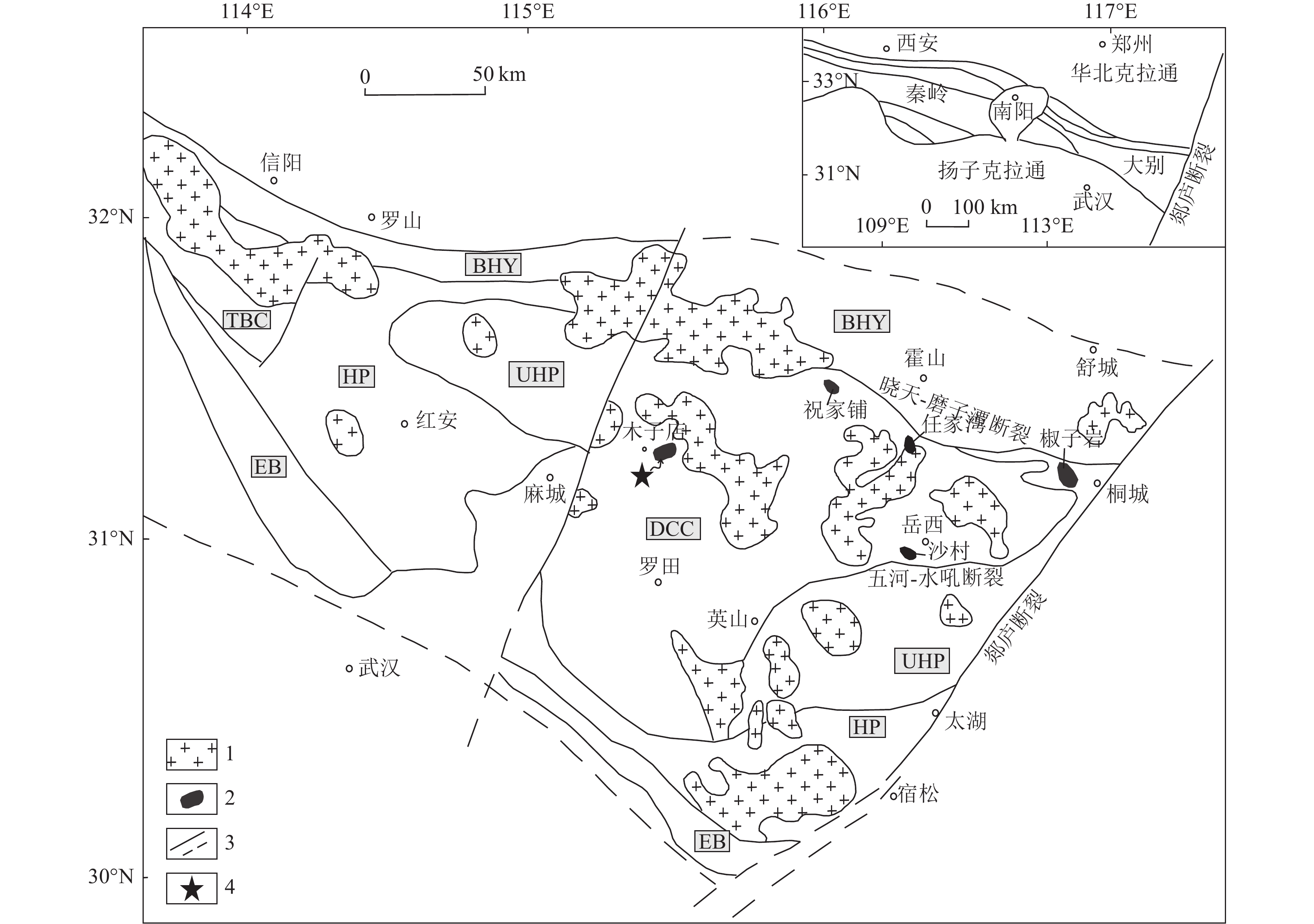
 下载:
下载:
